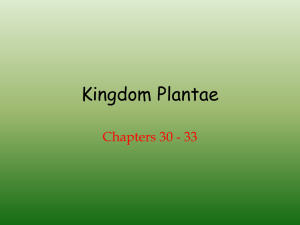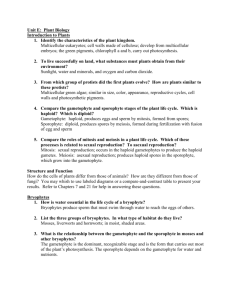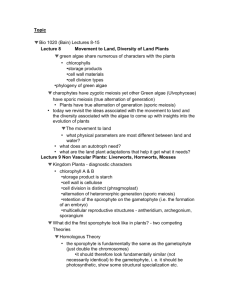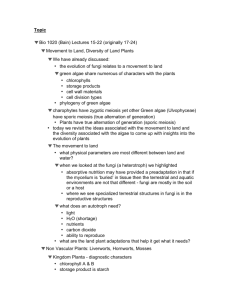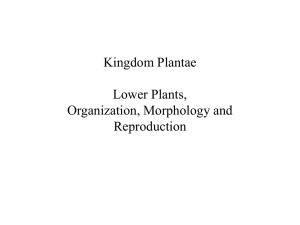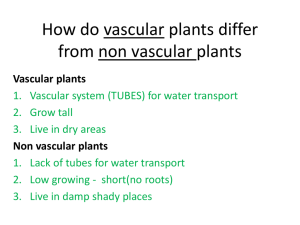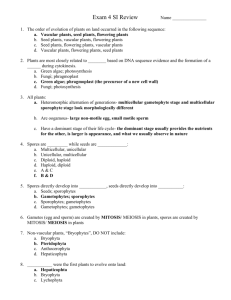Activity 29/30
advertisement
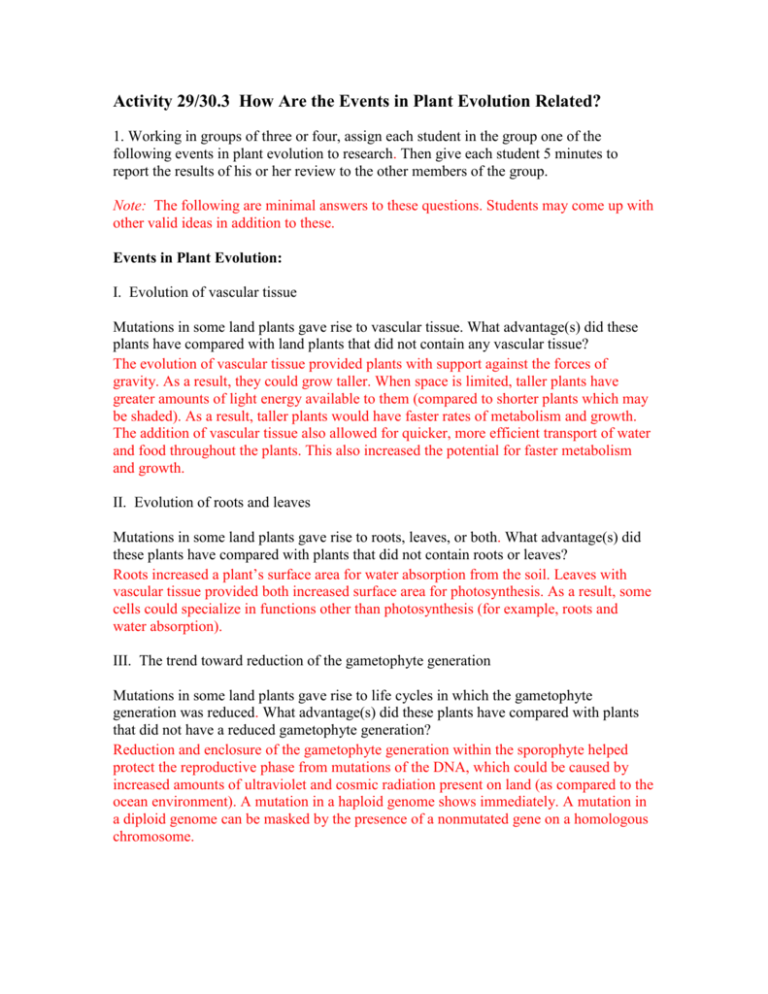
Activity 29/30.3 How Are the Events in Plant Evolution Related? 1. Working in groups of three or four, assign each student in the group one of the following events in plant evolution to research. Then give each student 5 minutes to report the results of his or her review to the other members of the group. Note: The following are minimal answers to these questions. Students may come up with other valid ideas in addition to these. Events in Plant Evolution: I. Evolution of vascular tissue Mutations in some land plants gave rise to vascular tissue. What advantage(s) did these plants have compared with land plants that did not contain any vascular tissue? The evolution of vascular tissue provided plants with support against the forces of gravity. As a result, they could grow taller. When space is limited, taller plants have greater amounts of light energy available to them (compared to shorter plants which may be shaded). As a result, taller plants would have faster rates of metabolism and growth. The addition of vascular tissue also allowed for quicker, more efficient transport of water and food throughout the plants. This also increased the potential for faster metabolism and growth. II. Evolution of roots and leaves Mutations in some land plants gave rise to roots, leaves, or both. What advantage(s) did these plants have compared with plants that did not contain roots or leaves? Roots increased a plant’s surface area for water absorption from the soil. Leaves with vascular tissue provided both increased surface area for photosynthesis. As a result, some cells could specialize in functions other than photosynthesis (for example, roots and water absorption). III. The trend toward reduction of the gametophyte generation Mutations in some land plants gave rise to life cycles in which the gametophyte generation was reduced. What advantage(s) did these plants have compared with plants that did not have a reduced gametophyte generation? Reduction and enclosure of the gametophyte generation within the sporophyte helped protect the reproductive phase from mutations of the DNA, which could be caused by increased amounts of ultraviolet and cosmic radiation present on land (as compared to the ocean environment). A mutation in a haploid genome shows immediately. A mutation in a diploid genome can be masked by the presence of a nonmutated gene on a homologous chromosome. IV. Evolution of the seed Mutations in some land plants gave rise to the seed. What advantages did these plants have compared with plants that did not have seeds? The seed contains a partially developed 2n embryo (the product of fertilization of the egg by a sperm from the pollen tube), a food store for its early development, and a protective coating (derived from the integuments surrounding the ovule) that allows it to survive periods of desiccation. You can think of the seed as an embryo, with a packed lunch, and a raincoat that is sent out into the world to make it on its own. A seed has two main advantages over a spore: The embryo is in a more advanced state of development, and the larger food store both allows for longer periods of dormancy and supports early growth phases of the seedling following germination. Upon germination, the food store in the seed allows it to continue developing roots, stem, and leaves until the plant breaks through the soil surface and is capable of photosynthesis. 2. Work together as a group to determine how these events in plant evolution (I to IV) might be related. For example, which would have to come first (in evolution), which next, and so on? Another way to look at this question is to consider which of these events paved the way (or made it possible) for the other events to occur. Be sure to state evidence for your proposed evolutionary scheme. To do this, it is useful to ask yourself questions like these: Would it have been possible for the seed to evolve without vascular tissue first having evolved? Leaves? And so on. If yes, how could this have occurred? If no, why not? Because roots and leaves contain vascular tissue, vascular tissue must have evolved first. When we look at the evolution of dominance of the sporophyte generation versus evolution of the seed, it is most likely that the sporophyte generation became dominant before the seed evolved. This order is supported by fossil evidence. Even if it weren’t supported by fossil evidence, however, this sequence seems most logical for the protection of both the gametophyte generation and the subsequent or offspring sporophyte generation. In combination, it is again logical (and supported by the fossil record) that the vascular system and leaves and roots evolved prior to the seed because the production of seeds is costly in terms of energy. 3. Incorporate the following true observations into your analysis of how the events in evolution (I to IV) could be related:. a. The fossil record (spore evidence and so on) indicates that the first plants on Earth were similar to modern-day bryophytes. This indicates that the first plants were likely to have a dominant gametophyte generation and no vascular tissue. b. The very large marine brown algae (for example, giant kelp) can grow to heights of 30 feet or more. These algae have both leaflike and stemlike structures and are held to the bottom of the sea by a holdfast. When examined microscopically, the algae are found to contain transport vessels that are similar to phloem in function. These giant kelp do not contain any xylemlike vessels, however, nor do they have roots. This provides evidence for the coevolution of transport systems. In the ocean, a food transport system evolved, and this allowed organisms like the giant kelp to evolve. With efficient food transport systems, photosynthetic parts of the plant nearer the surface of the water were able to supply food to nonphotosynthetic parts, which were not exposed to sufficient light energy. (Note: No water transport system evolved. Fitness would not be increased by the addition of a water transport system because all parts of the plant were equally exposed to water.) c. The first land plants with xylem and phloem had no leaves or roots. This indicates that there was a selective advantage to having xylem and phloem alone. In other words, the addition of xylem and phloem allowed plants to grow taller. Xylem enabled water to be transported quickly to regions at a distance from the soil. In addition, some parts of the plants could be shaded and still be “fed” by transporting sugars from photosynthetic parts. Taller plants were less likely to be shaded and as a result were able to gather more energy per unit time. Thus, they had better survival and reproductive rates than shorter plants. d. Some seedless vascular sporophyte plants do not release megaspores. Instead, the megaspore divides on the sporophyte (in the old sporangium) to produce the female gametophyte. This female gametophyte produces eggs in archegonia, which are fertilized by sperm produced in antheridia of this or other plants. Neither the female gametophyte (once formed) nor the developing embryo receives nutrition from the old sporophyte plant. This information allows us to recognize how the stage could have been set for evolution of a seed (containing the offspring sporophyte) that was dependent on the parent sporophyte plant. 4. Write an analysis of how these events could be related. Each change in evolution builds on what already exists. Observations a, c, and d provide evidence for this. Observation b, on the other hand, indicates that similar environmental conditions often select for similar “evolutionary solutions.” In this case, the evidence indicates that effective means of transport are required for photosynthetic organisms to grow taller. In the aquatic environment, gravity and water availability were not problems. As a result, food transport mechanisms alone were required. On land, plants had to deal with all three problems: support against gravity as well as food and water transport. Therefore, on land, plants had to evolve mechanisms to overcome these problems in order to grow taller.
